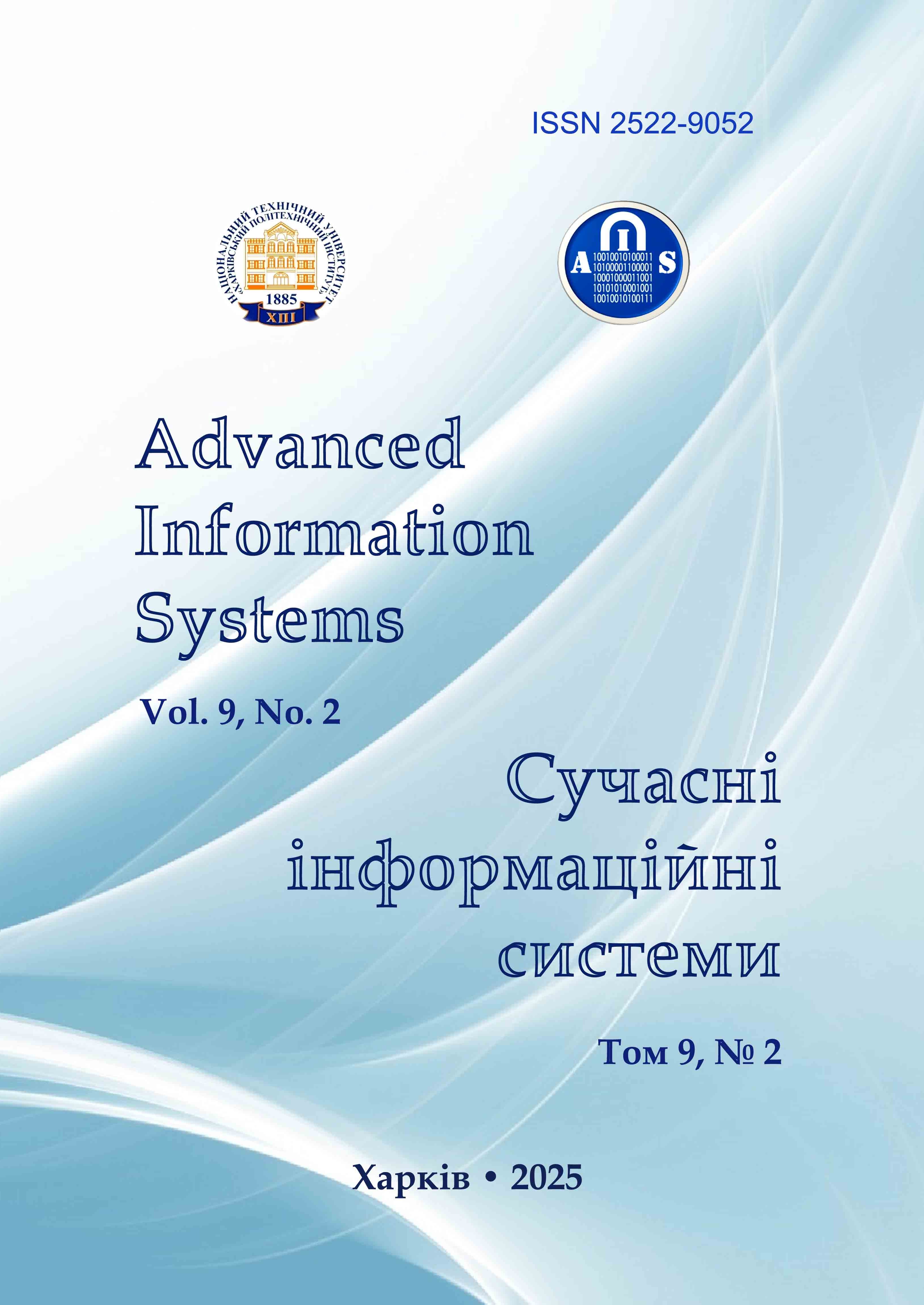COMPRESSION OF NOISY GRAYSCALE IMAGES WITH COMPRESSION RATIO ANALYSIS
Main Article Content
Abstract
The object of the study is the process of compressing noisy images in a lossy manner by better portable graphics (BPG) encoder. The subject of the study is the method for adaptive selection of the coder parameter Q depending on noise intensity and image complexity. The goal of the study is to consider the basic characteristics of lossy compression of remote sensing images contaminated by additive white Gaussian noise with giving recommendations of preferable Q setting. Methods used: numerical simulation, verification for test images. Results obtained: 1) the dependencies of compression ratio on Q are monotonically increasing functions; 2) their characteristics are strongly dependent on noise intensity and image complexity; 3) dependencies of logarithm of CR on Q contain information on possible existence and position of optimal operation point for compressed noisy images; 4) compression ratios for large Q contain information on image complexity with low sensitivity to noise presence and intensity; 5) it is possible to get useful information from dependences of compression ratio on Q. Conclusions: the results of this research allow: 1) estimating image complexity; 2) adapting Q to noise intensity and image complexity.
Article Details
References
Joshi, N, Baumann, M, Ehammer, A, Fensholt, R, Grogan, K, Hostert, P, Jepsen, M, Kuemmerle, T, Meyfroidt, P, Mitchard, E. and Waske, B. (2016), “A Review of the Application of Optical and Radar Remote Sensing Data Fusion to Land Use Mapping and Monitoring”, Remote Sensing, vol. 8(1), article number 70, doi: https://doi.org/10.3390/rs8010070
Suetens, P. (2017), Fundamentals of medical imaging, Third edition, Cambridge University Press, Cambridge, 257 p., available at: https://www.amazon.com/Fundamentals-Medical-Imaging-Paul-Suetens/dp/1107159784
Bataeva, E. and Chumakova-Sierova, A. (2022), “Values in Visual Practices of Instagram Network Users”, in Integrated Computer Technologies in Mechanical Engineering, Nechyporuk, M., Pavlikov, V., Kritskiy, D. Eds., Lecture Notes in Networks and Systems; Springer International Publishing, Cham, vol. 367, number 273869, pp. 992–1002, available at: https://link.springer.com/chapter/10.1007/978-3-030-94259-5_76
Stankevich, S.A. and Gerda, M.I. (2020), “Small-size target’s automatic detection in multispectral image using equivalence principle”, Cent. Eur. Res. J., vol. 6(1), pp. 1–9, available at:
https://ceres-journal.eu/download.php?file=2020_01_01.pdf
Radosavljević, M., Brkljač, B,. Lugonja, P., Crnojević, V., Trpovski, Ž., Xiong, Z. and Vukobratović, D. (2020), “Lossy Compression of Multispectral Satellite Images with Application to Crop Thematic Mapping: A HEVC Comparative Study”, Remote Sensing, vol. 12, 1590, doi: https://doi.org/10.3390/rs12101590
Zemliachenko, A., Kozhemiakin, R., Uss, M., Abramov, S., Ponomarenko, N., Lukin, V., Vozel, B. and Chehdi, K. (2014), “Lossy compression of hyperspectral images based on noise parameters estimation and variance stabilizing transform”, Journal of Applied Remote Sensing, vol. 8(1), 25, doi: https://doi.org/10.1117/1.JRS.8.083571
Blanes, I., Magli, E. and Serra-Sagrista, J. (2014), “A Tutorial on Image Compression for Optical Space Imaging Systems”, IEEE Geosci. Remote Sens. Mag., vol. 2, pp. 8–26, doi: 10.1109/MGRS.2014.2352465
Hussain, J.A., Al-Fayadh, A. and Radi, N. (2018), “Image compression techniques: A survey in lossless and lossy algorithms”, Neurocomputing, vol. 300, pp. 44-69, doi: https://doi.org/10.1016/j.neucom.2018.02.094
Bondžulić, B., Stojanović ,N., Petrović, V., Pavlović, B. and Miličević, Z. (2021), “Efficient Prediction of the First Just Noticeable Difference Point for JPEG Compressed Images”, Acta Polytechnica Hungarica, vol. 18(8), pp. 201–220, doi: https://doi.org/10.12700/APH.18.8.2021.8.11
Blau, Y. and Michaeli, T. (2019), “Rethinking lossy compression: The rate-distortion-perception tradeoff”, International Conference on Machine Learning, PMLR, pp. 675–865, available at: http://proceedings.mlr.press/v97/blau19a.html
Bellard, F. (2018), BPG image format, available at: http://bellard.org/bpg/
Yee, D., Soltaninejad, S., Hazarika, D., Mbuyi, G., Barnwal, R. and Basu, A. (2017), “Medical image compression based on region of interest using better portable graphics (BPG)”, IEEE International Conference on Systems, Man, and Cybernetics (SMC), pp. 216–221, doi: https://doi.org/10.1109/SMC.2017.8122605
Li, F. and Lukin, V. (2023), “Providing a Desired Compression Ratio for Better Portable Graphics Encoder of Color Images”, Design and Analysis, Digitalization and Management Innovation, Proceedings of DMI 2022, IOS Press, pp. 633–640, doi: https://doi.org/10.3233/FAIA230063
Kovalenko, B., Lukin, V., Kryvenko, S., Naumenko, V. and Vozel, B. (2022), “BPG-Based Automatic Lossy Compression of Noisy Images with the Prediction of an Optimal Operation Existence and Its Parameters”, Appl. Sci., vol. 12, 7555, doi: https://doi.org/10.3390/app12157555
Chatterjee, P. and Milanfar, P. (2010), “Is Denoising Dead?”, IEEE Transactions on Image Processing, vol. 19, no. 4, pp. 895–911, doi: https://doi.org/10.1109/TIP.2009.2037087
Al-Chaykh, O.K. and Mersereau, R/M. (1998), “Lossy compression of noisy images”, IEEE Transactions on Image Processing, vol. 7, is. 12, pp. 1641–1652, doi: https://doi.org/10.1109/83.730376
Chang, S., Yu, G. and Vetterli, M. (2000), “Adaptive wavelet thresholding for image denoising and compression”, IEEE Trans. on Image Processing, vol. 9, is. 9, pp. 1532–1546, doi: https://doi.org/10.1109/83.862633.
Kovalenko, B. and Lukin, V. (2023), “BPG-based compression of Poisson noisy images”, Proceedings of DESSERT’2023, Athens, Greece, 2023, 8 p., doi: https://doi.org/10.1109/DESSERT61349.2023.10416544
Wang, Z., Simoncelli, E. P. and Bovik, A. C. (2003), “Multiscale structural similarity for image quality assessment”, The Thirty-Seventh Asilomar Conference on Signals, Systems & Computers, vol. 2, pp. 1398–1402, doi: https://doi.org/10.1109/ACSSC.2003.1292216
Nafchi, Z. H., Shahkolaei, A., Hedjam, R. and Cheriet, M. (2016), “Mean Deviation Similarity Index: Efficient and Reliable Full-Reference Image Quality Evaluator”, IEEE Access, vol. 4, pp. 5579–5590, doi:
https://doi.org/10.1109/ACCESS.2016.2604042
Kryvenko, S., Lukin, V. and Vozel, B. (2024), “Lossy Compression of Single-channel Noisy Images by Modern Coders”, Remote Sensing, vol. 16, doi: https://doi.org/10.3390/rs16122093
Abramov, S., Lukin, V., Vozel, B., Chehdi, K. and Astola, J. (2008), “Segmentation-based method for blind evaluation of noise variance in images”, SPIE Journal on Applied Remote Sensing, vol. 2, Aug. 2008, 15 p. doi: https://doi.org/10.1117/1.2977788
Pyatykh, S., Hesser, J. and Zheng, L. (2013), “Image Noise Level Estimation by Principal Component Analysis”, IEEE Transactions on Image Processing, pp. 687–699, doi: https://doi.org/10.1109/TIP.2012.2221728
Pavlović, B., Bondžulić, B., Stojanović, N., Petrović, V. and Bujaković D. (2023), “Prediction of the first just noticeable difference point based on simple image features”, ZINC 2023, Novi Sad, Serbia, May 29-31, Proc. of papers, pp. 125–130, doi: https://doi.org/10.1109/ZINC58345.2023.10173865
Bondžulić, B., Stojanović, N., Lukin, V. and Kryvenko, S. (2024), “JPEG and BPG visually lossless image compression via KonJND-1k database”, Vojnotehnički glasnik, Military Technical Courier, vol. 72, no. 3, pp. 1214–1241, 2024, doi: https://doi.org/10.5937/vojtehg72-50300
Pogrebnyak, O. and Lukin, V. (2012), “Wiener DCT Based Image Filtering”, Journal of Electronic Imaging, no 4, 14 p., doi: https://doi.org/10.1117/1.JEI.21.4.043020
